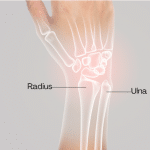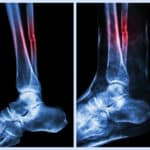Is it Jumper’s Knee? Key Facts on Patellar Tendinitis and How to Cope

Patellar tendinitis, commonly referred to as “jumper’s knee,” is a painful and often debilitating condition that affects the knee joint. This injury is especially common among athletes and active individuals who are engaged in high-impact activities. The condition targets the patellar tendon, a thick, fibrous band that connects the kneecap (patella) to the shinbone (tibia). […]
Distal Radius Fracture (Colles’ Fracture): Causes, Signs, and Recovery Tips

A distal radius fracture, or Colles’ fracture, is among the most common wrist fractures. It occurs when the radius, one of the two long bones in the forearm, breaks near the wrist. This injury often occurs from a fall on an outstretched hand and poses a higher risk to certain populations. Distal radius fractures rank […]
Common Shoulder Injuries in Athletes: Causes, Treatment, and Recovery

Common shoulder injuries often occur in athletes due to the joint’s wide range of motion. The shoulder is one of the most mobile joints, making it more vulnerable to overuse. Sports like swimming, tennis, baseball, and weightlifting use repetitive shoulder movements. This constant use heightens the risk of common shoulder injuries. Athletes who push their […]
Rotator Cuff Surgery Recovery: Stages, Tips, and Timeline

Rotator cuff surgery recovery generally takes a minimum of several months—but for those suffering from a torn rotator cuff, surgical repair can be instrumental in providing needed pain relief and functionality. Knowing what to expect while healing and how to manage pain and regain strength after surgery can help you regain the quality of life […]
Thumb Pain: Common Causes and Treatments

Having a thumb makes you relatively unique in the animal kingdom. Yet most of us take our thumbs for granted—until they cause problems. When your thumb hurts, using your hand as normal becomes surprisingly difficult. Yet, understanding why you have thumb pain and how to treat it isn’t always obvious or easy. You might have […]
The Hidden Risks of a Scaphoid Fracture: How To Avoid Long-Term Complications

Imagine you’re skiing, playing a quick pick-up game, or simply taking a walk when you suddenly catch an edge or trip and start to fall. Instinctively, you reach out to catch yourself, landing hard on your outstretched hand. Hours later, your wrist is swollen and aching. Even if your symptoms don’t seem that serious, you […]
Sprain vs Fracture: Is Your Bone Broken?

If you’ve rolled your ankle or caught yourself with an outstretched arm, you may have done some Googling for symptoms of a sprain vs. fracture. But since both can cause acute pain, swelling, and bruising, it can be hard to tell whether you simply need to let it rest or if you’ll end up getting […]
Fibula Fracture: Types & Treatment

You may recall from high school anatomy that you have two long bones in your lower leg: the tibia and the fibula. A fibula fracture is when you break the thinner of those bones that runs along the outside of your leg, the fibula. You can suffer a fibula fracture from a forceful impact, a […]
Nursemaid Elbow: Causes, Symptoms, & Treatments

Picture this: You’re walking around the neighborhood hand-in-hand with your child. You cross the street and playfully pull them up over the curb by the hand. They cry out in pain. What possibly could have happened? If you’re a parent or caregiver for a child, you’ve certainly done this, and likely without any idea it […]
6 Ways to Treat Shoulder Bone Spurs

Bone spurs in your shoulders are growths that form when your shoulder bones rub against each other. Spurs in the shoulders may also develop due to degenerative joint conditions like arthritis or as a result of an injury. Sometimes, these bony growths cause pain or impact movement, but not always. Depending on how shoulder bone […]